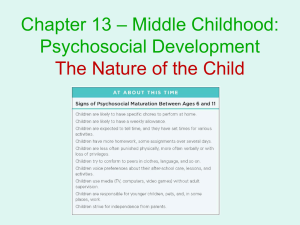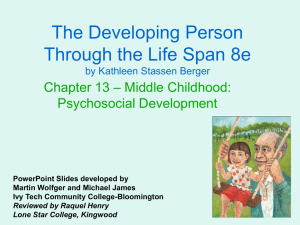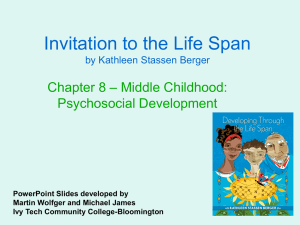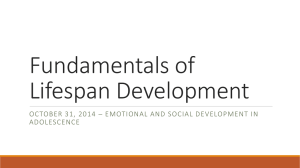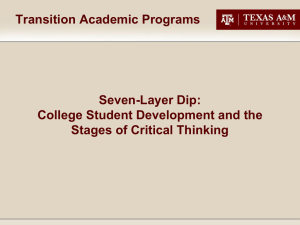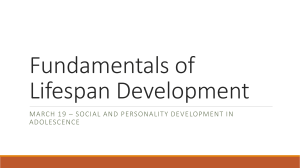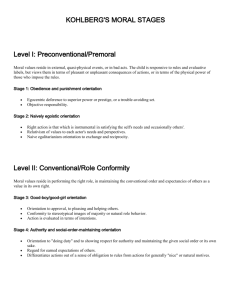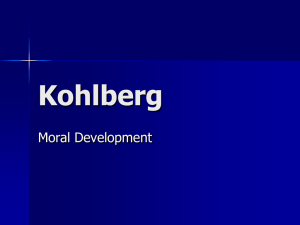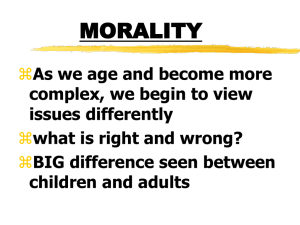Middle Childhood Psychosocial Development: Chapter Summary
advertisement
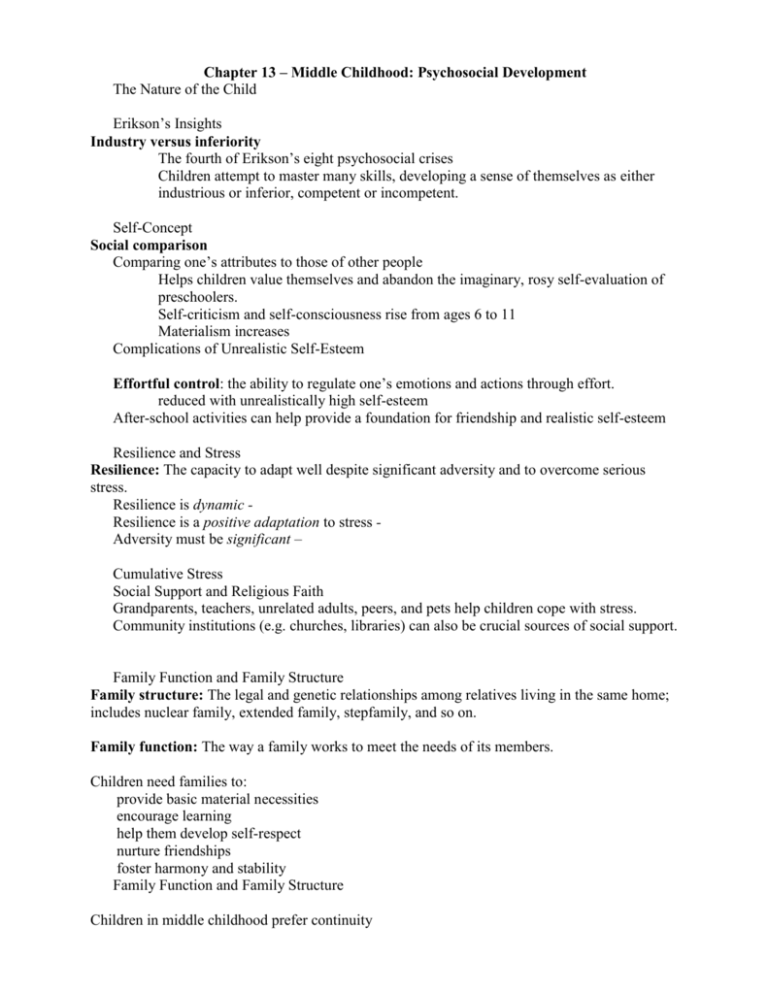
Chapter 13 – Middle Childhood: Psychosocial Development The Nature of the Child Erikson’s Insights Industry versus inferiority The fourth of Erikson’s eight psychosocial crises Children attempt to master many skills, developing a sense of themselves as either industrious or inferior, competent or incompetent. Self-Concept Social comparison Comparing one’s attributes to those of other people Helps children value themselves and abandon the imaginary, rosy self-evaluation of preschoolers. Self-criticism and self-consciousness rise from ages 6 to 11 Materialism increases Complications of Unrealistic Self-Esteem Effortful control: the ability to regulate one’s emotions and actions through effort. reduced with unrealistically high self-esteem After-school activities can help provide a foundation for friendship and realistic self-esteem Resilience and Stress Resilience: The capacity to adapt well despite significant adversity and to overcome serious stress. Resilience is dynamic Resilience is a positive adaptation to stress Adversity must be significant – Cumulative Stress Social Support and Religious Faith Grandparents, teachers, unrelated adults, peers, and pets help children cope with stress. Community institutions (e.g. churches, libraries) can also be crucial sources of social support. Family Function and Family Structure Family structure: The legal and genetic relationships among relatives living in the same home; includes nuclear family, extended family, stepfamily, and so on. Family function: The way a family works to meet the needs of its members. Children need families to: provide basic material necessities encourage learning help them develop self-respect nurture friendships foster harmony and stability Family Function and Family Structure Children in middle childhood prefer continuity Diversity of Structures Nuclear family: A family that consists of a father, a mother, and their biological children under age 18. Tend to be wealthier, better educated, healthier, more flexible, and less hostile Biological parents tend to be very dedicated to their offspring Similar advantages occur for children who are adopted Single-parent family: A family that consists of only one parent and his or her children under age 18. Children in single-mother families fare worse in school and in adult life than most other children. Single-mother households are often low-income and unstable, move more often and add new adults more often. Extended family: A family of three or more generations living in one household. Polygamous family: A family consisting of one man, several wives, and the biological children of the man and his wives. Connecting Structure and Function Two Same-sex Parents: Make up less than 1% of two-parent households Children are from previous marriage, assisted reproduction or adoption Connecting Structure and Function Stepparent Family: Has a financial advantage but has a disadvantage of instability Blended family: A stepparent family that includes children born to several families, such as the biological children from the spouses’ previous marriages and the biological children of the new couple. Family Trouble Family-stress model: the crucial question to ask about any risk factor (e.g. poverty, divorce, job loss, eviction) is whether or not it increases the stress on a family The family-stress model contends that the adults’ stressful reaction to poverty is crucial in determining the effect on the children. Children feel a need for harmony Parents who habitually fight are more likely to divorce, move, and otherwise disrupt the child’s life. Remarriage of divorced parents is often difficult for children due to jealousy, stress, and conflict. Children frequently suffer if parents physically or verbally abuse each other. The Peer Group Culture of children: The particular habits, styles, and values that reflect the set of rules and rituals that characterize children as distinct from adult society. Fashion Language Peer culture Friendship and Social Acceptance School-age children value personal friendship more than peer acceptance. Gender differences Girls talk more and share secrets. Boys play more active games. Friendships lead to psychosocial growth and provide a buffer against psychopathology. Older children: Demand more of their friends Change friends less often Become more upset when a friendship ends Find it harder to make new friends Seek friends who share their interests and values Popular and Unpopular Children Aggressive-rejected: Children who are disliked by peers because of antagonistic, confrontational behavior Withdrawn-rejected: Children who are disliked by peers because of their timid, withdrawn, and anxious behavior Social Awareness Social Cognition: the ability to understand social interactions, including the causes and consequences of human behavior. May be crucial for peer acceptance. Well-liked children tend to like themselves and usually assume that social slights are accidental. Bullies and Victims Bullying: Repeated, systematic efforts to inflict harm through physical, verbal, or social attack on a weaker person. Bully-victim: Someone who attacks others and who is attacked as well Also called a provocative victim because he or she does things that elicit bullying, such as stealing a bully’s pencil Children’s Moral Values Kohlberg’s Levels of Moral Thought Lawrence Kohlberg (1963) described stages of morality stemming from three levels of moral reasoning, with two stages at each level: Preconventional moral reasoning: Emphasizes rewards and punishments Conventional moral reasoning: Emphasizes social rules Postconventional moral reasoning: Emphasizes moral principles Criticisms of Kohlberg Kohlberg ignored culture and gender. Kohlberg’s levels could be labeled personal (preconventional), communal (conventional), and worldwide (postconventional) family is not included. The participants in Kohlberg’s original research were all boys. What Children Value Children develop their own morality, guided by peers, parents and culture Concrete operational cognition gets them to think about morality and to try to be ethical. When child culture conflicts with adult morality, children often align themselves with peers.
